Hungerford Arcade and everyone living in or associated with this beautiful town is very proud of the history of Hungerford. The most famous inhabitant of Hungerford is, of course, John of Gaunt. Our wonderful friend and author, Stuart Miller-Osborne, has written this fascinating article about this very famous man and his life. I hope you enjoy reading it as much as I did.
 What is noticeable when one is in Hungerford, are the references to a certain John of Gaunt. There is an inn named after him near the two rivers as well as a school that bears his name on the hill above the town. But who was John of Gaunt and why is his name so intertwined with the history of Hungerford? To find out we will have to go back to the reign of Edward the Second (1307-1327).
What is noticeable when one is in Hungerford, are the references to a certain John of Gaunt. There is an inn named after him near the two rivers as well as a school that bears his name on the hill above the town. But who was John of Gaunt and why is his name so intertwined with the history of Hungerford? To find out we will have to go back to the reign of Edward the Second (1307-1327).
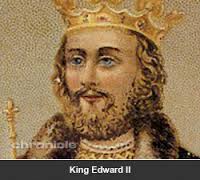 It is known that the King visited the town on June 19th 1308. But let us jump forward some fourteen years as this is a record of history only. A certain Thomas Earl of Lancaster and Leicester who was beheaded for treason in Pontefract in 1322 and had his properties forfeited to the Crown. The King however, learnt that Thomas’ widow, Alice, had Hungerford settled on her after her husband’s death along with the profits from the manor.
It is known that the King visited the town on June 19th 1308. But let us jump forward some fourteen years as this is a record of history only. A certain Thomas Earl of Lancaster and Leicester who was beheaded for treason in Pontefract in 1322 and had his properties forfeited to the Crown. The King however, learnt that Thomas’ widow, Alice, had Hungerford settled on her after her husband’s death along with the profits from the manor.
This is where it gets slightly complicated. It seems that a neighbouring Lord, a man called Henry le Tyes from Chilton Foliat, had also been involved in the rebellion and was executed at the same time as Thomas. In 1327, his estates were settled on his brother Henry who died in 1345. His son of the same name, was created Duke of Lancaster by Edward the Third. When Henry died in 1361, Hungerford passed to his daughter, Maud (Matilda), who was called Maud of Bavaria and was married to a certain Duke of Zealand. Are you still with me ?
Maud, sadly died on the 10th of April 1362, which, in the greater scheme of things, is a date of interest in the story of Hungerford and John of Gaunt, as her estates were left to her younger sister, Blanche who was the wife of the King’s forth son whom, as we know, was John of Gaunt.
John of Gaunt had been created by the Duke of Lancaster and the Earl of Leicester and because of his wife, there originated his connection with Hungerford. Quite what happened to Thomas’ widow Alice and her possession of Hungerford is unclear, but by 1362, John of Gaunt and Hungerford were now being mentioned in the same breath.
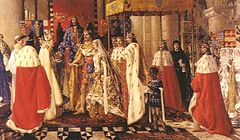 John and Blanche were married at Reading Abbey on Sunday, the 19th of May 1359, which although very much changed, still exists and is well worth a visit. I have recently read an account of the marriage in a book called The Marriage of John of Gaunt and Blanche of Lancaster at Reading Abbey (1917), which apart from giving an account of the wedding, gives pen-pictures of both John and Blanche which I will share with you.
John and Blanche were married at Reading Abbey on Sunday, the 19th of May 1359, which although very much changed, still exists and is well worth a visit. I have recently read an account of the marriage in a book called The Marriage of John of Gaunt and Blanche of Lancaster at Reading Abbey (1917), which apart from giving an account of the wedding, gives pen-pictures of both John and Blanche which I will share with you.
John of Gaunt
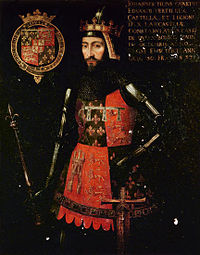 John of Gaunt was the fourth son of King Edward the Third. He was just nineteen years old when he married his cousin Blanche, the second daughter of Henry Duke of Lancaster. John is remembered as a tall and soldier-like man with a determined yet thoughtful countenance. Chaucer spoke of him as “a wonder wel-faringe knight of good mochel” (a wonderfully handsome knight of great size).
John of Gaunt was the fourth son of King Edward the Third. He was just nineteen years old when he married his cousin Blanche, the second daughter of Henry Duke of Lancaster. John is remembered as a tall and soldier-like man with a determined yet thoughtful countenance. Chaucer spoke of him as “a wonder wel-faringe knight of good mochel” (a wonderfully handsome knight of great size).
Blanche of Lancaster
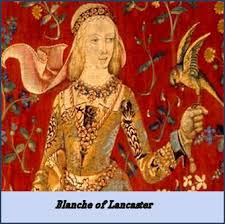 Blanche is noted as being a beautiful English blonde (An English Rose), who was tall like her husband and graceful in disposition. She was soft of speech and must have made an impression on Chaucer as she is mentioned in his Book of the Duchesse as follows;
Blanche is noted as being a beautiful English blonde (An English Rose), who was tall like her husband and graceful in disposition. She was soft of speech and must have made an impression on Chaucer as she is mentioned in his Book of the Duchesse as follows;
As the someres sonne bright
Is fairer, clerer and hath more light
Than any planete in heven
The mone or the sterres seven
For al the worlde, so had she
Surmounted hem alle of beaute,
Of maner and of comlinesse
Of stature and wel set gladnesse
Of goodlihede so well beseye (endowed)
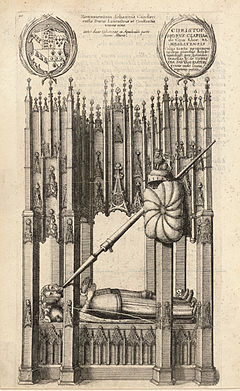 The description is typically Chaucer’s and with most of his work, can be read in a number of ways. But Blanche, who was an early patron of the poet, would I believe, have been amused (if not flattered) by his description of her. Blanche, who was a years younger than John and in the ten years of their marriage, bore him five children, one of whom married the future King of Portugal. Sadly, Blanche died of the plague on the 12th September 1369, her sister and father having already succumbed to the disease. She was buried in St Paul’s Cathedral and was later joined by John on his death in 1399.
The description is typically Chaucer’s and with most of his work, can be read in a number of ways. But Blanche, who was an early patron of the poet, would I believe, have been amused (if not flattered) by his description of her. Blanche, who was a years younger than John and in the ten years of their marriage, bore him five children, one of whom married the future King of Portugal. Sadly, Blanche died of the plague on the 12th September 1369, her sister and father having already succumbed to the disease. She was buried in St Paul’s Cathedral and was later joined by John on his death in 1399.
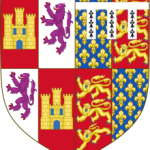 Upon his marriage to Blanche, John inherited North Standen as well as Hungerford Manor and Sandon Fee (a rural estate that lay around the town). He also held the manor of Charleton (Charnham Street) as well as the Overlord-ship of nearby Eddington although, some of the nearby areas were still held directly by the Crown.
Upon his marriage to Blanche, John inherited North Standen as well as Hungerford Manor and Sandon Fee (a rural estate that lay around the town). He also held the manor of Charleton (Charnham Street) as well as the Overlord-ship of nearby Eddington although, some of the nearby areas were still held directly by the Crown.
History relates that Edward the Third granted a Charter to Hungerford and John later granted himself the rights of free fishing from Eldren Stub to the Irish Stile (with the exception of some privately owned waters). The Charter is also said to confer rights of hunting grazing and fishing to householders living in the main street in Hungerford. This Charter itself appears to have been lost in 1381 during the Peasants Revolt so its history is that of some dispute. What is known however, is that the inhabitants of Hungerford were granted a large number of rights and privileges, unusual at the time and since. John is generally thought to have granted these but again, this is disputed in some quarters. In short, John is credited in granting free fishing rights on the River Kennet between Elder Stubb (just below Leverton) to the Irish Stile (near Kinbury) to the inhabitants of the town as well as other privileges.
The John of Gaunt Horn
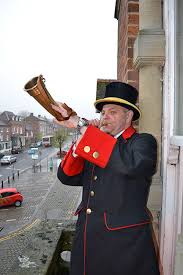 There is also the John of Gaunt Horn, which is supposed to have been made to guarantee the previously noted rights. The horn has Hungerford on one side with the word Actel (or Astel) on the other along with the crescent and star, which is now recognisable as the badge of the town. This said, the horn dates from the fifteenth century (John died in 1399), but what is known, is that for some two hundred years (1365 -1565), Hungerford enjoyed John of Gaunt Privileges with the profits of markets and fairs as well as the free fishery being a right.
There is also the John of Gaunt Horn, which is supposed to have been made to guarantee the previously noted rights. The horn has Hungerford on one side with the word Actel (or Astel) on the other along with the crescent and star, which is now recognisable as the badge of the town. This said, the horn dates from the fifteenth century (John died in 1399), but what is known, is that for some two hundred years (1365 -1565), Hungerford enjoyed John of Gaunt Privileges with the profits of markets and fairs as well as the free fishery being a right.
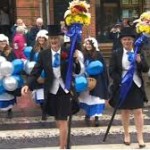 Why this came to an end is the subject for a different article, but whilst you cannot still fish freely on the Kennet, the sight of the yearlings grazing freely on Hungerford Common and the annual Hocktide (Tutti Day), gives a clue to the town’s past.
Why this came to an end is the subject for a different article, but whilst you cannot still fish freely on the Kennet, the sight of the yearlings grazing freely on Hungerford Common and the annual Hocktide (Tutti Day), gives a clue to the town’s past.
Whatever John of Gaunt did or did not grant is a subject for historians, but it all contributes to the unique feel of our town.
Stuart Miller-Osborne
